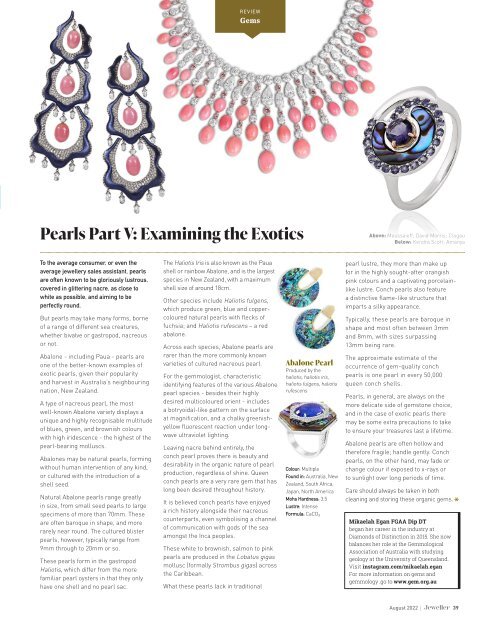Jeweller - August 2022
Create successful ePaper yourself
Turn your PDF publications into a flip-book with our unique Google optimized e-Paper software.
REVIEW<br />
Gems<br />
Pearls Part V: Examining the Exotics<br />
Above: Moussaieff; David Morris; Clogau<br />
Below: Kendra Scott; Amanya<br />
To the average consumer, or even the<br />
average jewellery sales assistant, pearls<br />
are often known to be gloriously lustrous,<br />
covered in glittering nacre, as close to<br />
white as possible, and aiming to be<br />
perfectly round.<br />
But pearls may take many forms, borne<br />
of a range of different sea creatures,<br />
whether bivalve or gastropod, nacreous<br />
or not.<br />
Abalone - including Paua - pearls are<br />
one of the better-known examples of<br />
exotic pearls, given their popularity<br />
and harvest in Australia’s neighbouring<br />
nation, New Zealand.<br />
A type of nacreous pearl, the most<br />
well-known Abalone variety displays a<br />
unique and highly recognisable multitude<br />
of blues, green, and brownish colours<br />
with high iridescence - the highest of the<br />
pearl-bearing molluscs.<br />
Abalones may be natural pearls, forming<br />
without human intervention of any kind,<br />
or cultured with the introduction of a<br />
shell seed.<br />
Natural Abalone pearls range greatly<br />
in size, from small seed pearls to large<br />
specimens of more than 70mm. These<br />
are often baroque in shape, and more<br />
rarely near round. The cultured blister<br />
pearls, however, typically range from<br />
9mm through to 20mm or so.<br />
These pearls form in the gastropod<br />
Haliotis, which differ from the more<br />
familiar pearl oysters in that they only<br />
have one shell and no pearl sac.<br />
The Haliotis Iris is also known as the Paua<br />
shell or rainbow Abalone, and is the largest<br />
species in New Zealand, with a maximum<br />
shell size of around 18cm.<br />
Other species include Haliotis fulgens,<br />
which produce green, blue and coppercoloured<br />
natural pearls with flecks of<br />
fuchsia; and Haliotis rufescens – a red<br />
abalone.<br />
Across each species, Abalone pearls are<br />
rarer than the more commonly known<br />
varieties of cultured nacreous pearl.<br />
For the gemmologist, characteristic<br />
identifying features of the various Abalone<br />
pearl species - besides their highly<br />
desired multicoloured orient - includes<br />
a botryoidal-like pattern on the surface<br />
at magnification, and a chalky greenishyellow<br />
fluorescent reaction under longwave<br />
ultraviolet lighting.<br />
Leaving nacre behind entirely, the<br />
conch pearl proves there is beauty and<br />
desirability in the organic nature of pearl<br />
production, regardless of shine. Queen<br />
conch pearls are a very rare gem that has<br />
long been desired throughout history.<br />
It is believed conch pearls have enjoyed<br />
a rich history alongside their nacreous<br />
counterparts, even symbolising a channel<br />
of communication with gods of the sea<br />
amongst the Inca peoples.<br />
These white to brownish, salmon to pink<br />
pearls are produced in the Lobatus gigas<br />
mollusc (formally Strombus gigas) across<br />
the Caribbean.<br />
What these pearls lack in traditional<br />
Abalone Pearl<br />
Produced by the<br />
haliotis, haliotis iris,<br />
haliotis fulgens, haliotis<br />
rufescens<br />
Colour: Multiple<br />
Found in: Australia, New<br />
Zealand, South Africa,<br />
Japan, North America<br />
Mohs Hardness: 3.5<br />
Lustre: Intense<br />
Formula: CaCO ³<br />
pearl lustre, they more than make up<br />
for in the highly sought-after orangish<br />
pink colours and a captivating porcelainlike<br />
lustre. Conch pearls also feature<br />
a distinctive flame-like structure that<br />
imparts a silky appearance.<br />
Typically, these pearls are baroque in<br />
shape and most often between 3mm<br />
and 8mm, with sizes surpassing<br />
13mm being rare.<br />
The approximate estimate of the<br />
occurrence of gem-quality conch<br />
pearls is one pearl in every 50,000<br />
queen conch shells.<br />
Pearls, in general, are always on the<br />
more delicate side of gemstone choice,<br />
and in the case of exotic pearls there<br />
may be some extra precautions to take<br />
to ensure your treasures last a lifetime.<br />
Abalone pearls are often hollow and<br />
therefore fragile; handle gently. Conch<br />
pearls, on the other hand, may fade or<br />
change colour if exposed to x-rays or<br />
to sunlight over long periods of time.<br />
Care should always be taken in both<br />
cleaning and storing these organic gems.<br />
Mikaelah Egan FGAA Dip DT<br />
began her career in the industry at<br />
Diamonds of Distinction in 2015. She now<br />
balances her role at the Gemmological<br />
Association of Australia with studying<br />
geology at the University of Queensland.<br />
Visit instagram.com/mikaelah.egan<br />
For more information on gems and<br />
gemmology ,go to www.gem.org.au<br />
<strong>August</strong> <strong>2022</strong> | 39


















